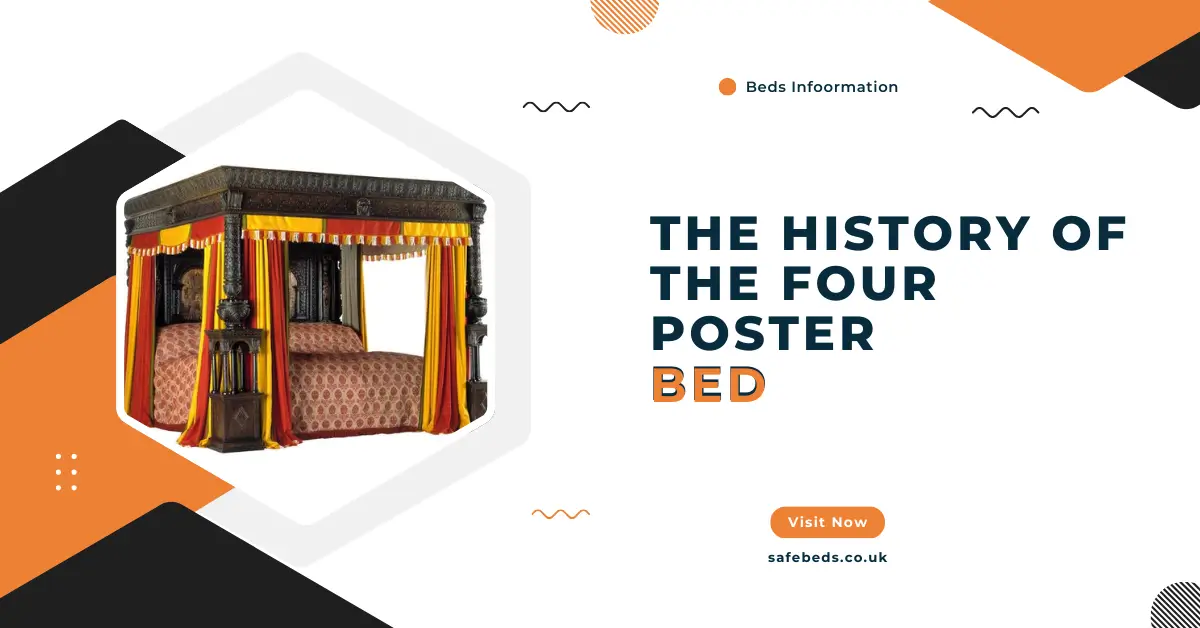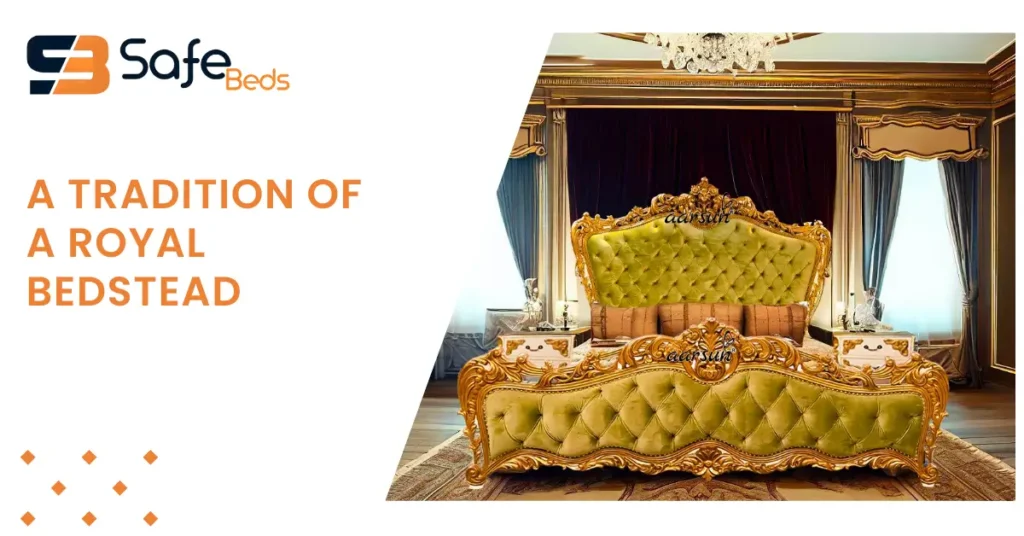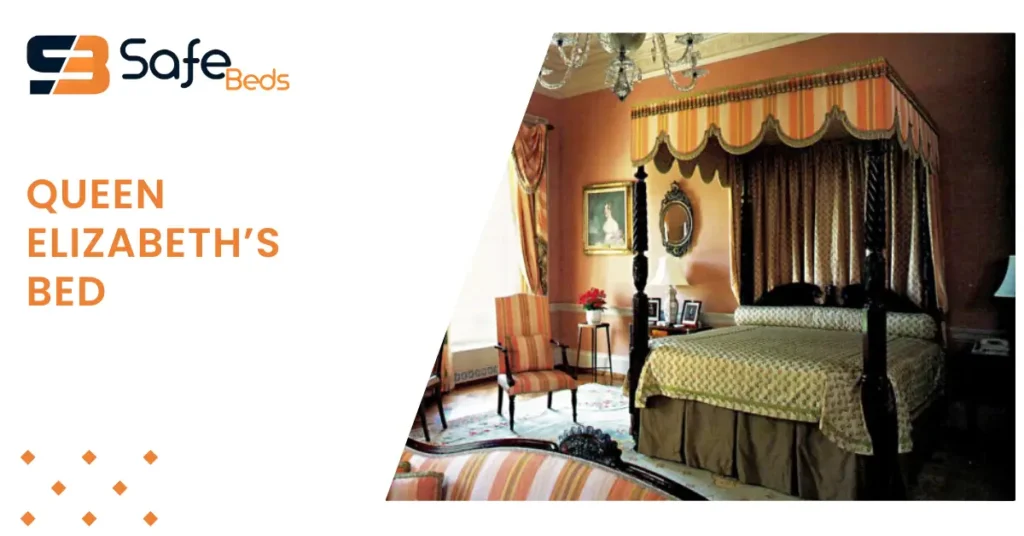The Origins of the Iconic Four Poster Bed

The bedstead has evolved. This change shows how lifestyles, comfort needs, and social status have shifted. Early Saxon beds were basic wooden platforms set in recesses. Curtains added warmth but also trapped illness.
As design improved, Norman-era beds added iron rails. These rails allowed for hanging drapes, which provided privacy and insulation. By the 13th century, the humble truckle bed became common, allowing servants to sleep beneath their masters.
Around this time, the canopy bed emerged. This marked a shift to more stylish and practical sleeping options.
The four-poster bed, or great standing bed, featured detailed carvings and rich fabrics. It often dominated the bedroom space. The Great Bed of Ware is the most famous. It now sits in the Victoria and Albert Museum. This bed measures an impressive 11 feet square. It symbolizes the era’s opulence.
Contents
- 1 || A Tradition of a Royal Bedstead
- 1.1 || Mediaeval Beds and Bedding
- 1.2 || Queen Elizabeth’s Bed
- 1.3 FAQs: (Frequently Ask Questions)
- 1.3.1 1. What is a four-poster bed, and why is it significant?
- 1.3.2 2. How were four-poster beds used in history?
- 1.3.3 3. What are the key features of a four-poster bed?
- 1.3.4 4. Are four-poster beds still considered luxurious today?
- 1.3.5 5. What are common problems with four-poster beds, and how can I solve them?
- 1.3.6 6. How does a four-poster bed compare to other types of beds?
- 1.3.7 7. Are four-poster beds worth the investment?
- 1.3.8 8. What materials are four-poster beds made of?
|| A Tradition of a Royal Bedstead

The four-post bed has long been associated with grandeur and wealth, a true symbol of royalty. Roger Twysden noted an interesting event in Notes and Queries about Richard III, who famously slept on a four-post bedstead in Leicester at the Boar’s Head Inn. This bed was richly carved, gilded, and decorated with a double bottom of boards.
This heavy bedstead remained a fixture of the inn long after Richard’s defeat at Bosworth Field, and despite being stripped of its rich hangings, it became a lasting piece of history.
The story only grew more intriguing when Clark, the innkeeper’s wife during Queen Elizabeth’s reign, discovered a hidden treasure: gold coins tucked away in the double bottom of the bed, coins from Richard III’s era and even earlier times. This old tradition kept the bed as a centrepiece of Leicester’s local lore, passed from tenant to tenant as a valued item.
The famous Great Bed of Ware, now displayed at the Victoria & Albert Museum, is another magnificent example of such craftsmanship. This Tudor bed, known for its heavy carving and Renaissance patterns like acanthus leaves and strapwork, was a sight to behold.
Constructed in the 1590s, it was intended as an early form of PR in tourism by an innkeeper in Ware, Hertfordshire, who used it to attract visitors travelling between Cambridge and London.
Despite alterations over time, including changes to the columns, traces of the original design, such as remnants of brightly coloured paint on the headboard and tester, can still be seen today.
|| Mediaeval Beds and Bedding
In the mediaeval era, beds were far more than simple sleeping arrangements; they were a symbol of wealth and prestige. A bed included not only the structure but also curtains, hangings, a tester, and other appendages like the colour, creating an opulent display.
Nobles showcased elaborate trimmings with coverlids or counterpoints made of gold cloth and adorned with a fringe. A dorsar, as luxurious as the one found in the state chair of a royal hall, often hung above the bedding, especially in Henry III’s palaces.
By the fourteenth century, barons took pride in their rich silk fabrics imported from the East, commonly seen among the French nobility but less frequent in England.
As a mark of affluence, noble households had beds embroidered with extravagant designs such as ships, birds, and Eastridge feathers. Some were made of Chinese cloth of Tars or arras (tapestry) adorned with scenes of hunting and hawking. These portable beds, known as trussing beds, were carefully managed by yeomen bedgoers and transported from one manor to another.
Noteworthy was the Duc d’Orleans and his chambre portative, complete with dorsar curtains and a coverlid estimated to be worth a fortune. The feather beds, introduced from France in the early fourteenth century, were a coveted luxury in English homes, laid over a matted truss of straw.
To keep warm, woollen blankets and artificial heating methods such as warmed bricks and bed pans were employed, especially since most rooms lacked a fireplace.
|| Queen Elizabeth’s Bed

The Virgin Queen of England, Queen Elizabeth I, had the most opulent and lavish bed of her time, as documented by a wardrobe warrant in 1581. This royal bedstead was crafted from walnut tree, a rare wood in England, and was richly carved, painted, and gilt to reflect her grandeur.
The seller, tester, and Vallance were made from cloth of silver, intricately adorned with velvet and taffeta, and lined with Venice gold, silver, and silk. The curtains were not just functional but also highly decorative, made from tapestry and elaborately worked with borders of gold lace, silver lace, and bullion.
Adding to its splendour, the headpiece was made of crimson satin from Bruges. It was bordered with passamayne of crimson silk and adorned with extravagant ostrich feathers, all sparkling with golden spangles.
The counterpoint, a patchwork of orange-coloured satins, was equally impressive, embroidered with Venice gold, silver spangles, and coloured silks and lined with orange sarcenet.
The use of oak as the dominant timber in the Jacobean era made such intricate woodwork accessible only to the wealthiest in palaces or homes of the rich. By the seventeenth century, furniture styles evolved further.
James I popularized Jacobean furniture with Renaissance motifs and decorative inlay using fruitwoods, bog oak, and even ivory and mother-of-pearl. The legs of tables and buffets during this period were turned into bulbous shapes, later giving rise to vase shapes, bobbin turning, and the barley-sugar twist legs that defined the style.
In seventeenth-century France, the introduction of taller bedsteads with beechwood frames gained prominence in the larger homes of the wealthy. These taller posts, along with the cornice, ceilings, and quilt, were upholstered in the same materials as the curtains and valance, creating a seamless and opulent design.
For example, James I slept in a parcel-gilt bed at Knole, which was hung with gold and silver tissue, the ultimate in regal luxury. This period also saw a rise in the use of plainer oak bedsteads for the less wealthy, featuring panelled low backs and lacking the elaborate posts and ceiling treatments of their more ornate counterparts.
The bedstead was considered a sacred possession in many households, particularly for widows, as it often symbolized the space where many life events took place, including childbirth and death.
Some of these simpler bedsteads, like the truckle bed, were used by servants and could be packed for travelling or stored under larger beds during the day. This was a far cry from the mourning bed of the same era, which was entirely draped in black, even down to the white sheets and pillowcases.
By the time of the Restoration Stuart bedstead, Stuart beds had become medium-height, made from carved wood with coordinating valance and hangings around the wooden headboard, offering both function and beauty while blocking out the cold, draughty air in the larger, loftier bedchambers of the time.
Conclusion
The history of the four-poster bed reflects centuries of evolution in both design and cultural significance. From its early beginnings as a basic symbol of wealth and status among Saxon and Norman noblemen to its iconic role as the bed of kings, this bedstead has continuously embodied grandeur.
Over time, the bed transformed from simple structures into highly ornate and luxurious pieces, with the Tudor and Elizabethan eras marking the pinnacle of its craftsmanship. Beds like Queen Elizabeth’s walnut masterpiece or the great bed of Ware showcased intricate carvings, rich fabrics, and extravagant embellishments.
By the seventeenth century, styles evolved to incorporate Jacobean and French influences, reflecting a shift in both furniture design and social customs. Throughout its history, the four-poster bed has remained a timeless classic, blending practicality, art, and status in a single, majestic form.
FAQs: (Frequently Ask Questions)
1. What is a four-poster bed, and why is it significant?
A four-poster bed is a bed with four tall posts, one at each corner. These posts support an upper frame or canopy.
In history, these luxury beds were symbols of status. They were often used by royalty and wealthy families. More than just furniture, four-poster beds provided warmth, comfort, and privacy. Curtains around the bed helped block cold air and added elegance. Over time, these beds evolved, showcasing craftsmanship from different eras like the Tudor and Jacobean periods.
2. How were four-poster beds used in history?
In earlier times, four-poster beds were placed in the grandest rooms of castles and mansions. Large rooms were often cold and drafty. The thick curtains around these beds helped keep warmth inside.
Wealthy families made these beds from fine materials like oak and walnut. They decorated them with rich fabrics such as velvet, silk, and tapestry. The canopy and curtains also blocked light and added beauty to the room. These beds combined luxury with practical use.
3. What are the key features of a four-poster bed?
A four-poster bed has four tall posts supporting a canopy. This design allows curtains to be draped around the bed. These curtains offer warmth, privacy, and elegance.
In the past, these beds were made from strong woods like walnut and oak. Many had detailed carvings, gilded accents, and decorative headboards. The canopy was more than just decoration. It made the bed feel cozy and enclosed.
4. Are four-poster beds still considered luxurious today?
Yes, four-poster beds are still a symbol of luxury and elegance. Modern designs have changed, but they still capture the grand style of the past.
Many high-end homes and luxury hotels feature these beds. They bring historical charm while offering modern comfort. Their fine craftsmanship and customizable fabrics make them a favorite for stylish interiors.
5. What are common problems with four-poster beds, and how can I solve them?
One common issue is their size. In small rooms, a four-poster bed can feel overwhelming. A solution is to choose a lighter, more minimalist design. This keeps the elegance without making the space feel cramped.
Another issue is dust buildup on the curtains and canopy. Regular cleaning helps keep the bed fresh. Choosing machine-washable fabrics also makes maintenance easier.
For older four-poster beds, loose screws or fittings can cause instability. Checking and tightening the posts regularly ensures the bed stays sturdy.
6. How does a four-poster bed compare to other types of beds?
A four-poster bed stands out for its height, grandeur, and decoration. Other beds, like platform or sleigh beds, offer a simpler look.
Four-poster beds provide extra warmth and privacy with their enclosed design. They also create a bold focal point in the bedroom. If you want a bed that is both practical and stylish, a four-poster bed is a great choice.
7. Are four-poster beds worth the investment?
A four-poster bed is a good investment for those who value craftsmanship and luxury. These beds can be more expensive due to their size and materials. However, they are built to last and never go out of style.
They are also versatile. The canopy and curtains can be changed to match different seasons or decor styles. This makes them a flexible and timeless choice for any bedroom.
8. What materials are four-poster beds made of?
Traditional four-poster beds were made from strong woods like oak, walnut, and beech. These woods are durable and add a classic touch to any room.
Modern versions use a mix of materials. Some are still made of wood, while others combine wood with metal for a sleek, contemporary look. The material you choose affects the bed’s durability, style, and price.
